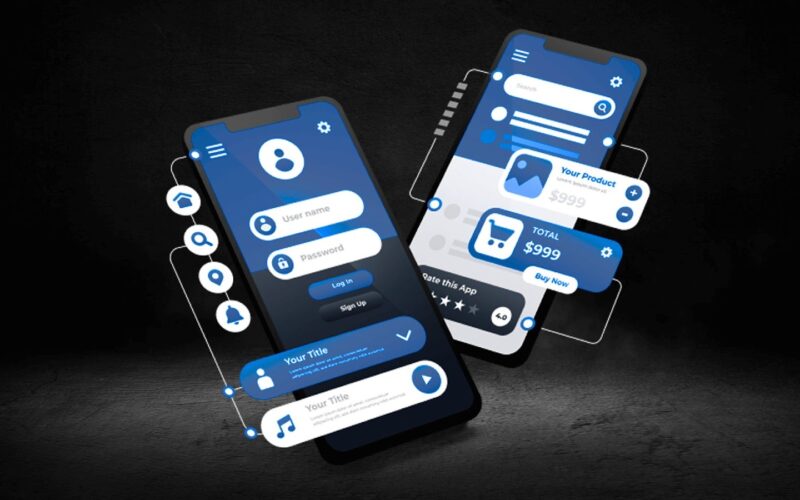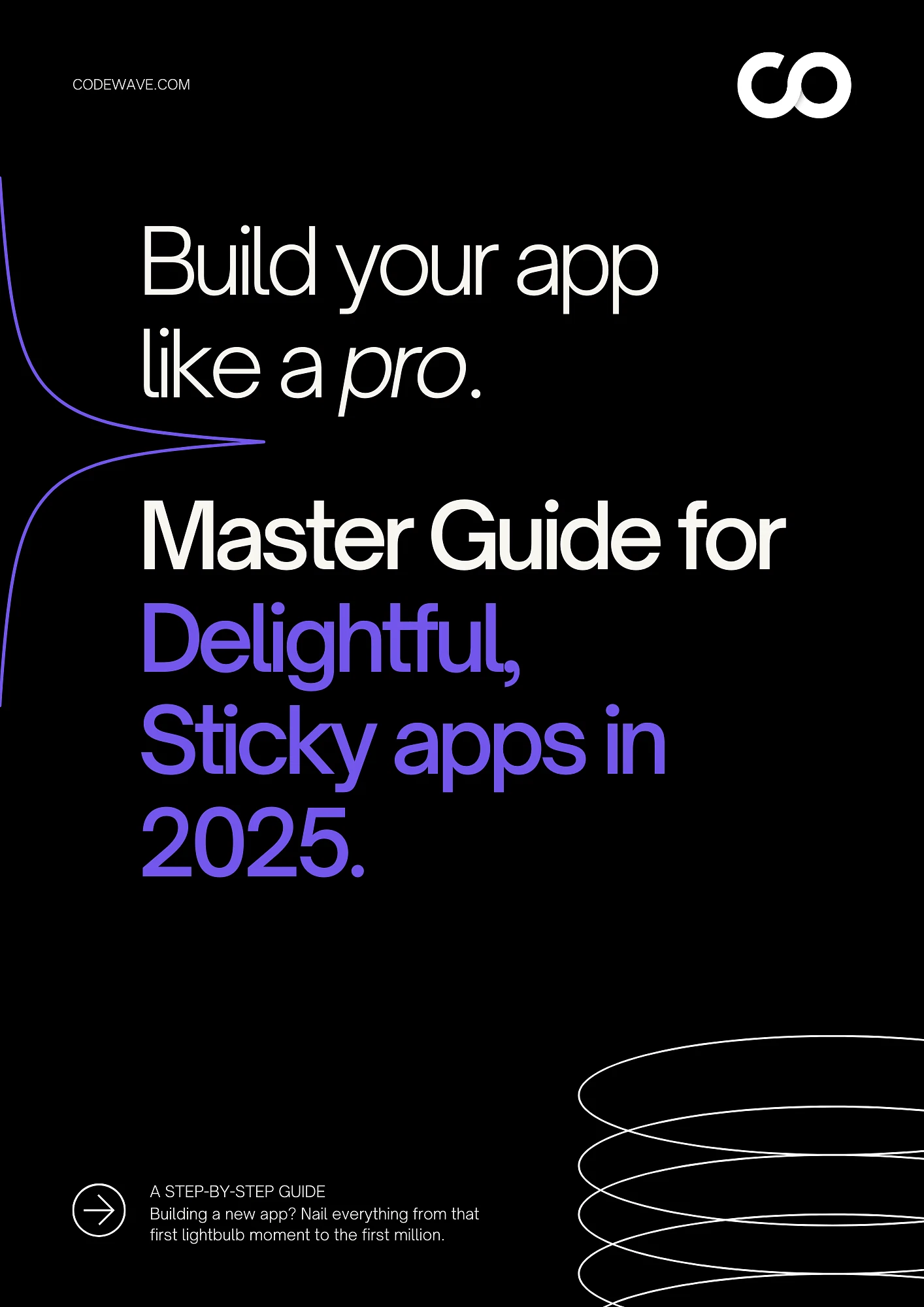Did you know that the demand for application development is growing rapidly? In fact, according to recent data, the global market for mobile apps was valued at over USD 252.89 billion in 2023 and is expected to more than double, reaching up to USD 626.39 billion by 2030.
The rapid growth in application development highlights why staying ahead of development trends is essential for businesses that want to stay competitive.
In this guide, you’ll know exactly which application development trends deserve your attention and how to apply them to your specific business. So, without any further ado, let’s get started!
Key Takeaways:
- Modern apps use artificial intelligence to personalize interactions, automate workflows, and provide intelligent insights that drive business value.
- Applications built for cloud environments offer better performance, cost efficiency, and the flexibility to grow with your business needs.
- Low-code platforms speed up development while maintaining quality, making them ideal for businesses that need to move fast.
- Building once and deploying everywhere can reduce development expenses.
- Processing data closer to users results in faster response times and better user experiences, especially for real-time applications.
What are the Current Trends in Application Development?
Application development trends show how businesses adapt to changing user expectations, technological capabilities, and market demands.
For instance, companies like Netflix and Spotify have built their success on applications that deliver personalized, fast, and reliable experiences to millions of users simultaneously.
Current trends focus heavily on speed, scalability, and user experience. Businesses want applications that can be developed quickly, scale effortlessly, and provide exceptional user experiences across all devices.
These trends shape how applications get built today, but just knowing about them isn’t enough if you don’t see how they affect your business.
Why Do Application Development Trends Matter?
Keeping up with application development trends directly affects your ability to serve customers, compete effectively, and operate efficiently in today’s market.
Here’s why these trends are essential:
- Customer expectations keep rising: Modern customers expect applications to be fast, intuitive, and available across all their devices, and falling behind means losing customers to competitors who deliver better experiences.
- Development costs and speed matter: Companies implementing the right trends often reduce their development costs while launching products much faster than traditional approaches.
- Market opportunities are time-sensitive: The speed advantage from modern development practices can mean the difference between capturing market opportunities and watching competitors get there first.
- Operational efficiency improves: Smart implementation of trends like automation and cloud-native approaches can reduce maintenance overhead and improve system reliability.
- Future-proofing protects investments: Choosing trends that align with long-term technology directions helps ensure your applications remain relevant and maintainable as technology evolves.
Getting the business impact clear is important, but the real question is which specific trends can actually help your situation. So, let’s find out.
Top 11 Trends in Application Development
These trends represent the most significant shifts in how applications are being built and deployed today. Each offers specific advantages for different business contexts and challenges.
Let’s explore the trends that can make the biggest difference for your business strategy:
1. Artificial Intelligence and Machine Learning Integration
AI and ML started in research labs decades ago, but 2022 changed everything when ChatGPT showed the world what modern AI could do. What used to require teams of data scientists and months of training can now be added to applications in weeks using services like OpenAI’s API, Google’s AI Platform, or AWS machine learning tools.
Simple AI tasks like sorting customer emails, generating product descriptions, or analyzing user feedback can now be built into applications using pre-made tools that work right out of the box.
Example: E-commerce platforms use AI to show relevant products based on browsing history and purchase patterns, financial apps detect fraudulent transactions instantly by analyzing spending behavior, and healthcare applications can identify potential health risks from user data patterns.
Implementation Tips:
- Pick one problem to solve first: Choose something like answering common customer questions or sorting incoming support tickets, then build a simple chatbot or classification system to handle that specific task.
- Use existing AI tools: Start with services like OpenAI’s API, Google’s AI Platform, or AWS AI services that give you ready-made capabilities instead of hiring data scientists to build models from scratch.
- Clean up your data now: Set up proper data collection in your current systems, remove duplicate records, and make sure you’re storing customer interactions consistently since AI needs good data to work properly.
Looking to add AI capabilities to your applications? Codewave’s AI/ML Development services can help you identify the right AI opportunities for your business and implement them effectively.
2. Cloud-Native Application Development
Cloud-native development approach uses microservices, containers, and orchestration tools to create applications that can scale automatically, recover from failures quickly, and deploy updates without downtime.
This trend has gained momentum because traditional applications often struggle with the scale and reliability demands of modern business. Cloud-native applications can handle traffic spikes automatically, distribute processing across multiple servers, and maintain high availability even when individual components fail. The approach also enables teams to deploy updates more frequently and respond faster to user feedback.
Example: Streaming services use cloud-native architectures to handle millions of concurrent users during peak viewing times, e-commerce platforms scale automatically during sales events, and SaaS applications maintain 99.9% uptime by distributing services across multiple cloud regions.
Implementation Tips:
- Build failure handling from day one: Write code that continues working when database connections drop or API calls fail, store error logs in multiple locations, and create backup plans for each critical system component.
- Set up automated alerts: Install monitoring tools like New Relic or DataDog that send you notifications when response times slow down, error rates increase, or servers run out of memory.
- Start with managed services: Use services like AWS Lambda, Google Cloud Run, or Azure Functions instead of managing your own servers, then add more control as your team gains experience.
3. Low-Code and No-Code Development Platforms
Low-code platforms started gaining serious attention around 2018 when Microsoft launched Power Platform and other major tech companies followed suit. What began as simple drag-and-drop website builders evolved into powerful development environments that can create complex business applications.
With these platforms, now marketing managers can build customer tracking systems, HR teams can create onboarding workflows, and operations staff can build inventory management tools without writing code.
Example: Companies use low-code platforms to build internal workflow tools, customer portals, and data dashboards that would previously require months of custom development. Insurance companies create claim processing applications, manufacturing companies build equipment monitoring dashboards, and service businesses develop customer management systems.
Implementation Tips:
- Test the platform with your actual data: Build a small version of your planned application using real business data to see if the platform can handle your specific workflow requirements and integration needs.
- Check customization options: Make sure you can add custom code, connect to your existing databases, and modify the user interface when the built-in options aren’t enough for your needs.
- Get IT approval early: Have your IT team review the platform’s security features, data backup processes, and compliance certifications before you build anything important on it.
4. Progressive Web Apps (PWAs)
Google introduced PWAs in 2015 as a way to make websites feel like native mobile apps. The technology combines the best of web and mobile. You get the reach of a website with the performance and features of an app, all without app store downloads.
PWAs load instantly, work offline, and can be installed directly from a web browser. This matters because app stores have become crowded and expensive, with long approval processes that slow down updates.
Example: Pinterest’s PWA increased user engagement significantly while reducing development costs. E-commerce sites use PWAs to provide app-like shopping experiences that work reliably even with poor internet connections.
Implementation Tips:
- Build the main features first: Create the core functionality users need most – like login, product browsing, and checkout for an e-commerce PWA – and make sure these work perfectly offline before adding extra features.
- Set up smart caching: Use service workers to save important pages and data on users’ devices automatically, and create simple loading screens that show cached content while waiting for fresh data.
- Test on cheap phones: Check your PWA performance on older Android devices with slow processors and limited memory since many users don’t have the latest smartphones.
5. Enhanced Application Security
Application security became critical after major breaches like Equifax in 2017 and countless others that followed. The introduction of GDPR in 2018 and similar privacy laws worldwide made security a legal requirement, not just a nice-to-have feature.
Modern security integrates protection throughout the development process instead of adding it at the end. Developers now build applications with the assumption they will be attacked, using techniques like zero-trust architecture, where every user and device must be verified before accessing any system.
Example: Financial applications use multi-factor authentication, behavioral analysis, and encrypted communications to protect sensitive data. Healthcare applications implement role-based access controls and audit trails to comply with privacy regulations. E-commerce platforms use fraud detection algorithms and secure payment processing to protect both businesses and customers.
Implementation Tips:
- Add security reviews to your development process: Schedule weekly code reviews where team members specifically look for vulnerabilities like SQL injection or exposed API keys, and use tools like SonarQube to scan code automatically.
- Set up automated security scanning: Install tools like OWASP ZAP or Snyk in your deployment pipeline to check for known vulnerabilities every time you release code updates.
- Create an incident response plan: Write down step-by-step instructions for what to do if you discover a security breach, including who to notify, how to stop the attack, and how to communicate with customers.
6. Cross-Platform Development Frameworks
Cross-platform frameworks got serious attention when Facebook released React Native in 2015. These tools let developers write code once and deploy it to both iOS and Android, solving the expensive problem of maintaining separate development teams for each platform.
This technology has improved dramatically since those early days. What used to result in slow, clunky apps now produces smooth experiences that feel native on each platform while sharing most of the underlying code.
Example: Companies like WhatsApp, Instagram, and Airbnb use React Native to deliver consistent experiences across mobile platforms while maintaining single development teams. Startups use cross-platform frameworks to launch on multiple platforms quickly with limited resources, and enterprises use them to maintain large applications more efficiently.
Implementation Tips:
- Test on both platforms early: Build a simple version of your app and install it on actual iOS and Android devices within the first two weeks to catch platform-specific issues before they become expensive to fix.
- Match your team’s coding skills: If your developers know JavaScript well, choose React Native. If they prefer Dart or need very smooth animations, pick Flutter instead of learning a completely new language.
- Plan for native features: Make a list of device features you’ll need (like camera access, push notifications, or GPS) and verify your chosen framework can handle them properly on both platforms.
7. Edge Computing Integration
Edge computing gained momentum when companies like Cloudflare started offering edge services, but really took off in the recent years when everyone needed faster, more reliable internet experiences.
Instead of sending all data to distant cloud servers, edge computing processes information closer to users. This approach reduces the time between when a user clicks something and when they see a response.
Example: Gaming applications use edge computing to reduce lag and provide smoother gameplay. Content delivery networks use edge servers to serve videos and images from locations closer to users. IoT applications process sensor data locally to provide immediate responses for safety-critical systems.
Implementation Tips:
- Pick features that need instant responses: Focus edge computing on things like user interface interactions, real-time game moves, or live video processing where even a 100-millisecond delay makes the experience feel slow.
- Plan for spotty internet connections: Build your edge services to store important data locally and sync with your main servers when internet becomes available, rather than failing completely when connections drop.
- Start with managed edge services: Use services like AWS CloudFront, Cloudflare Workers, or Azure Edge Zones instead of setting up your own edge servers until you know exactly what you need.
8. Microservices Architecture
Microservices architecture became popular after companies like Netflix and Amazon showed how breaking large applications into smaller pieces could solve scaling problems. Netflix’s move to microservices helped them handle millions of users streaming video simultaneously without their entire system crashing when one part failed.
The approach works by splitting large applications into independent services that each handle one specific job. When your payment system needs an update, you can change just that part without touching user accounts, product catalogs, or anything else.
Example: E-commerce platforms use separate microservices for user authentication, product catalog, shopping cart, and payment processing. If the payment service needs updates, it can be deployed independently without touching other parts of the system. Social media platforms use microservices to handle different functions like user profiles, messaging, and content feeds.
Implementation Tips:
- Group features by business function: Create separate services for things like user accounts, payments, and product catalogs instead of dividing by technical layers like database, API, and frontend.
- Set up centralized logging: Use tools like ELK Stack or Splunk to collect logs from all your services in one place, making it easier to track down problems when they cross multiple services.
- Build retry logic and fallbacks: When one service is down, have other services either try the request again after a few seconds or use backup data to keep working instead of crashing completely.
9. Voice and Conversational Interfaces
Voice interfaces took a major leap forward when Amazon released Alexa in 2014, followed by improvements in natural language processing that made chatbots actually useful instead of frustrating. The real breakthrough came with AI models like GPT that can handle complex conversations and context.
Business applications now include voice features that go beyond simple commands. Instead of typing “show me sales data for Q3,” users can ask “how did we do last quarter compared to the same time last year” and get intelligent responses.
Example: Business applications now include voice commands for data entry, report generation, and task management. Customer service applications use intelligent chatbots that can handle complex queries and escalate to human agents when needed. Smart home applications control multiple devices through natural language commands.
Implementation Tips:
- Map out conversation paths: Write down the most common questions users ask and how your system should respond, including what happens when users ask follow-up questions or change topics mid-conversation.
- Record real user testing sessions: Have actual users talk to your voice interface while you watch and take notes, since people often speak differently than they type and may use unexpected phrases.
- Add clear privacy controls: Put simple on/off switches in your app settings and explain in plain language what voice data you collect, where you store it, and how users can delete their recordings.
Building applications with voice capabilities? Codewave’s Custom Software Development services can help you integrate conversational interfaces that enhance user experiences.
10. Augmented Reality (AR) and Virtual Reality (VR)
AR and VR moved beyond gaming when Apple released ARKit in 2017 and Google followed with ARCore, making it possible for any smartphone to support AR experiences.
VR got more practical when headset prices dropped and companies like Oculus (now Meta) made the technology accessible to businesses. These technologies now solve real business problems instead of just creating cool demos.
Example: Retail applications use AR to let customers visualize furniture in their homes before purchasing. Manufacturing companies use AR to provide maintenance guidance directly on equipment. Training applications use VR to create safe, realistic learning environments for dangerous or expensive scenarios.
Implementation Tips:
- Start with one specific problem: Use AR to help customers see how furniture looks in their room or VR to train employees on dangerous procedures, rather than trying to create general AR/VR experiences that don’t solve clear business needs.
- Check what devices your users own: Survey your customers to see if they have smartphones that support AR or if they’re willing to use VR headsets, since these technologies need specific hardware to work properly.
- Keep sessions short: Design AR/VR experiences that last 5-10 minutes maximum to prevent eye strain and motion sickness, and include comfort breaks for longer training applications.
11. Internet of Things (IoT) Integration
IoT started with simple connected devices, but became more useful for businesses when wireless connectivity improved and sensor costs dropped dramatically.
Connected devices can now collect data from places and processes that were impossible to track before.
Example: Smart building applications monitor occupancy, temperature, and energy usage to optimize comfort and efficiency. Industrial applications track equipment performance and predict maintenance needs before failures occur. Agricultural applications monitor soil conditions and weather patterns to optimize irrigation and crop management.
Implementation Tips:
- Pick specific data you need: Decide exactly what information you want from connected devices – like temperature readings every hour or equipment vibration levels – and how you’ll use this data to make business decisions before buying any IoT hardware.
- Set up device monitoring tools: Use platforms like AWS IoT Device Management or Azure IoT Central to track which devices are online, check battery levels, and push software updates to devices in remote locations.
- Secure devices from day one: Change default passwords on all IoT devices, set up encrypted connections, and create separate network segments for IoT devices so they can’t access your main business systems if compromised.
These trends offer real opportunities for businesses willing to adopt them thoughtfully. The main challenge is choosing the right partner who can implement them effectively.
Build Applications that Matter with Codewave
Keeping up with application development trends is challenging when you’re focused on running your business. You need a partner who knows both the latest technologies and your business objectives.
Codewave combines deep technical expertise with design thinking to help businesses implement latest application development trends that drive real results. We’ve helped companies across industries build applications that users love and businesses can scale.
Here’s how we can help you leverage these trends:
- AI and ML integration: Custom AI solutions that automate workflows, personalize experiences, and provide intelligent insights for better decision-making
- Cloud-native development: Scalable, resilient applications built for modern cloud environments that grow with your business needs
- Cross-platform solutions: React Native and Flutter applications that work seamlessly across all devices while reducing development costs
- Progressive Web Apps: Fast-loading, app-like web experiences that engage users without the complexity of native app development
- Security-first approach: Applications built with integrated security measures to protect your business and customer data from evolving threats
Check out our portfolio to see how we’ve helped companies across industries build applications that solve real business problems and drive growth.
Ready to turn these trends into competitive advantages? Contact us today to implement these technologies effectively.
FAQs
1. What security measures should be prioritized in modern application development?
Multi-factor authentication, encrypted data transmission, and automated security testing should be standard. Regular security audits and real-time threat monitoring are essential for applications handling sensitive data.
2. How long does it take to implement cloud-native architecture?
Implementation time varies based on application complexity, but most businesses see initial benefits within 2-3 months. Full migration typically takes 6-12 months depending on existing system complexity.
3. Are Progressive Web Apps suitable for all types of businesses?
PWAs work best for businesses serving customers across multiple devices and platforms. They’re particularly effective for e-commerce, content sites, and service-based businesses but may not suit applications requiring extensive device integration.
4. What’s the biggest mistake businesses make when adopting new development trends?
Trying to implement too many trends at once without a clear business justification. Focus on 2-3 trends that solve your biggest challenges rather than chasing every new technology.
5. How can businesses measure the success of implementing these development trends?
Track metrics like user engagement, development speed, maintenance costs, and customer satisfaction. Set specific goals before implementation to measure actual impact versus expectations.
Codewave is a UX first design thinking & digital transformation services company, designing & engineering innovative mobile apps, cloud, & edge solutions.







